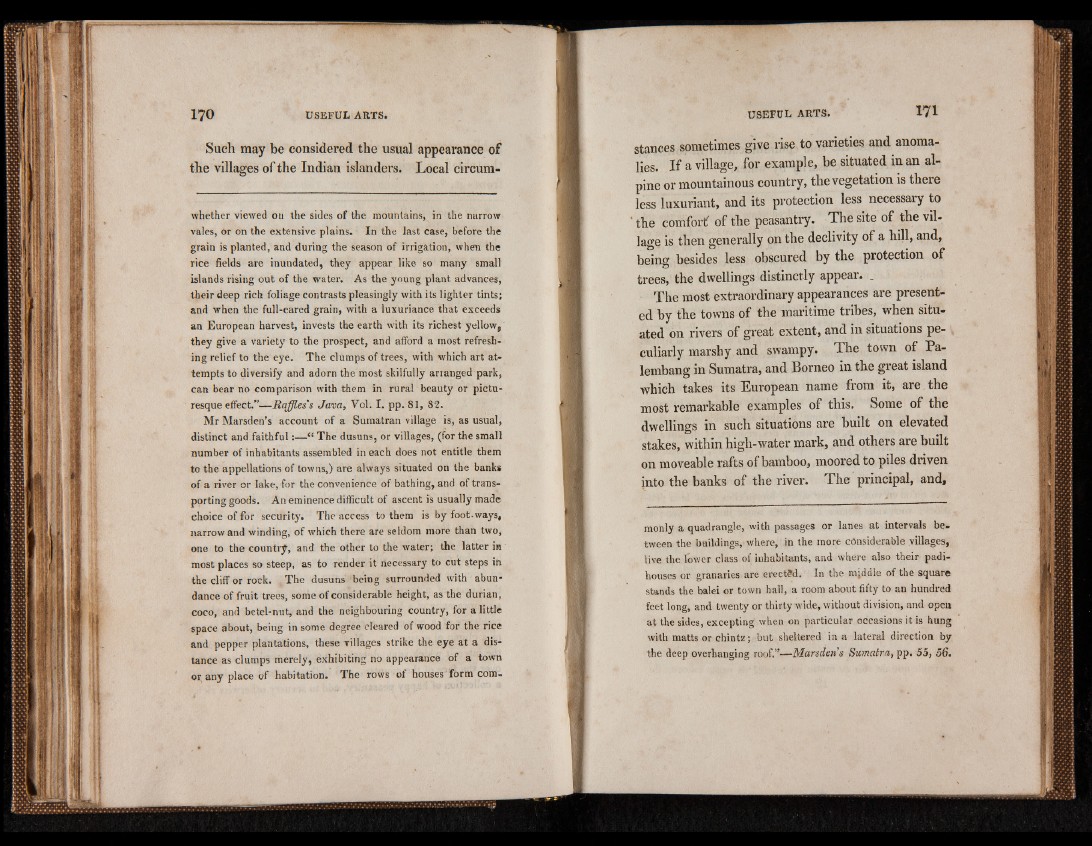
Such may be considered the usual appearance of
the villages of the Indian islanders. Local circumwhether
viewed ou the sides of the mountains, in the narrow
vales, or on the extensive plains. In the last case, before the
grain is planted, and during the season of irrigation, when the
rice fields are inundated, they appear like so many small
islands rising out of the water. As the young plant advances,
their deep rich foliage contrasts pleasingly with its lighter tints;
and when the full-eared grain, with a luxuriance that exceeds
an European harvest, invests the earth with its richest yellow,
they give a variety to the prospect, and afford a most refreshing
relief to the eye. The clumps of trees, with which art attempts
to diversify and adorn the most skilfully arranged park,
can bear no comparison with them in rural beauty or picturesque
effect.”— Raffles's Java, Vol. I. pp. 81, 82.
Mr Marsden’s account of a Sumatran village is, as usual,
distinct and faithful:—“ The dusuns, or villages, (for the small
number of inhabitants assembled in each does not entitle them
to the appellations of towns,) are always situated on the banks
of a river or lake, for the convenience of bathing, and of transporting
goods. An eminence difficult of ascent is usually made
choice of for security. The access to them is by foot-ways,
narrow and winding, of which there are seldom more than two,
one to the country, and the other to the water; the latter in
most places so steep, as to render it necessary to cut steps in
the cliff or rock. The dusuns being surrounded with abundance
of fruit trees, some of considerable height, as the durian,
coco, and betel-nut, and the neighbouring country, for a little
space about, being in some degree cleared of wood for the rice
and pepper plantations, these villages strike the eye at a distance
as clumps merely, exhibiting no appearance of a town
or any place of habitation. The rows of houses form com»
stances sometimes give rise to varieties and anomalies.
If a village, for example, be situated in an alpine
or mountainous country, the vegetation is there
less luxuriant, and its protection less necessary to
the comfort- of the peasantry. The site of the village
is then generally on the declivity of a hill, and,
being besides less obscured by the protection of
trees, the dwellings distinctly appear. .
The most extraordinary appearances are presented
by the towns of the maritime tribes, when situated
on rivers of great extent, and in situations peculiarly
marshy and swampy. The town of Pa-
lembang in Sumatra, and Borneo in the great island
which takes its European name from it, are the
most remarkable examples of this. Some of the
dwellings in such situations are built on elevated
stakes, within high-water mark, and others are built
on moveable rafts of bamboo, moored to piles driven
into the banks of the river. The principal, and,
monly a quadrangle, with passages or lanes at intervals between
the buildings, where, in the more considerable villages,
live the lower class of inhabitants, and where also their padi-
houses or granaries are erected. In the mjddle of the square
stands the balei or town hall, a room about fifty to an hundred
feet long, and twenty or thirty wide, without division, and open
at the sides, excepting when on particular occasions it is hung
with matts or chintz; but sheltered in a lateral direction by
the deep overhanging roof.”— Marsdens Sumatra, pp. 55, 56.